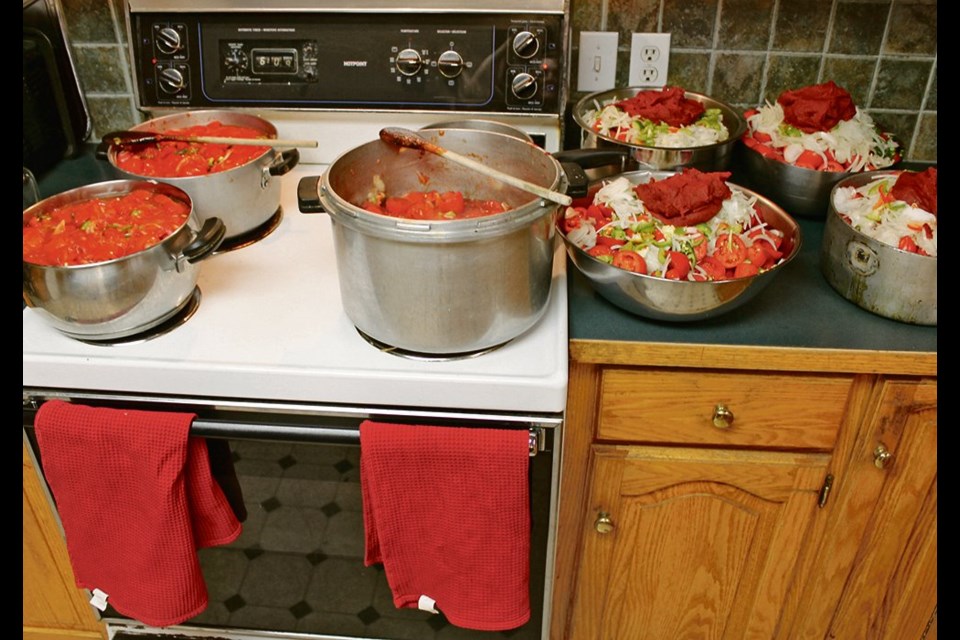WESTERN PRODUCER — Canning is the most common way to store the fall garden haul, but fermentation and dehydration are other options
In many places across the Prairies, gardeners are wrapping up another season.
Shining tomatoes, jewel-coloured carrots and beets, beautiful beans, sharp-tasting onions, earthy potatoes are coming out of the ground, pulled off the plants and lined up on kitchen counters.
But how best to preserve the summer’s bounty? What are some tried-and-tested ways of keeping summer all year round?
Andrew Hewson, chef instructor at the Southern Alberta Institute of Technology, finds that the best way to approach home preserving is to demystify the process.
“It’s going back to some of those traditional things our grandparents did automatically in the fall,” he says. “It’s really a lot of peasant foods — keeping food over winter was pure survival.”
Whether it’s canning, fermenting, dehydrating or cold-room storage, preserving food harvested now for the lean, dark days of winter has a long history and Hewson says with basic knowledge, anyone can do it.
For canning specifically, “the biggest anxiety is the whole botulism scare,” he says. “People are terrified but once you know the basics and some of the science behind it, it’s really easy. You should be aware but a lot of it comes down to good food handling practices in the kitchen.”
Food pH levels determine the best canning method for safety. For guidance, Hewson recommends checking the pH of fresh foods with pickyourown.org or through the U.S. Department of Agriculture Home Canning guidelines at the National Centre for Home Food Preservation. He also recommends against reusing discs or condiments jars bought from the grocery store.
“The risk is it may not seal,” he says. “Those generally only compress once.”
Anna Esau, a home gardening enthusiast and one of the faces behind Northern Homestead, a garden-and-food based blog centred on her growing experience near Didsbury, Alta., has preserved her harvest for years.
“It’s very rare that I would buy tomatoes, carrots, potatoes or onions,” she says. “I can a lot, it’s my number one storage choice.”
For Esau, a childhood in Kyrgzstan growing up watching her Ukrainian mother prepare and preserve food has meant that she keeps an open mind when it comes to her own cupboards.
“I’m kind of all over the place when looking for ways to preserve,” she says. “Our canning regulations are very different from the Russian or European standards. I’m not afraid to try.”
Canning isn’t the only option, however.
“Fermenting is one of the oldest forms of preserving food,” says Hewson. “Our ancestors survived on fermented food for thousands of years.”
Hewson encourages people to start simple.
“The first time can be a bit intimidating,” he says, but he points to the long history of fermentation, particularly in Eastern European, Indian and Asian cuisines.
“Any vegetable that comes out of your garden, you can ferment. Give them a good wash but don’t peel them. You want to keep that lactobacillus bacteria on the surface.”
Once the vegetable has been chopped, sliced or grated, “submerge in a two percent salt brine, make sure it’s covered and leave it to do its thing. The longer you let it ferment, the … funkier the flavour.”
Fermented foods can be stored in the refrigerator or root cellar. Any temperatures under 10 C will stop the fermentation process.
For some vegetables and fruits, dehydration may be your best choice. Canada’s Indigenous people have a long history of drying food for winter storage.
In 2007, the Yellowhead Tribal Council released a cookbook, Traditional Methods of Canning and Preserving, available for PDF download. Contributors came from across the province with basic how-tos on drying, storing and using saskatoons, chokecherries and bullberries (buffaloberries) along with other traditional foods.
If you don’t have a dehydrator, Hewson recommends heating your oven to its lowest temperature, laying out thinly sliced fruit or vegetables to dry on cookie sheets and then putting them in the oven, turning off the heat and leaving it overnight.
Finally, simple cold storage works well if you have the option — and the floor space. The process of “curing” — allowing vegetables to dry out slightly under controlled temperatures — is particularly well-suited to onions, beets, garlic, potatoes, carrots and squash.
“I have a four-month cold room,” says Esau. “It’s not a proper root cellar — the temperature and humidity is not as stable — but it’s much better than most modern houses.”
Inside her cold room, Esau will keep potatoes, zucchini and marrow squash.
“Pick a good, middle-sized squash, not too big,” she says. “Bring them into a cool, dark space. The skin will harden and it will keep for four months or so. It’s a great way to deal with the zucchini overload in summer.”
For Esau and Hewson, food storage strategies are about nourishment — for the body and the soul.
“It’s a great way of sharing,” says Hewson. “You see it happening through community gardens and community kitchens. Workshops, people getting together to learn and share.”
Esau agrees.
“Self-sufficiency is not my goal,” she says. “I enjoy seeing what other people grow. I like eating foods from other places. It’s part of the fun. And why not?”



.jpg;w=120;h=80;mode=crop)
